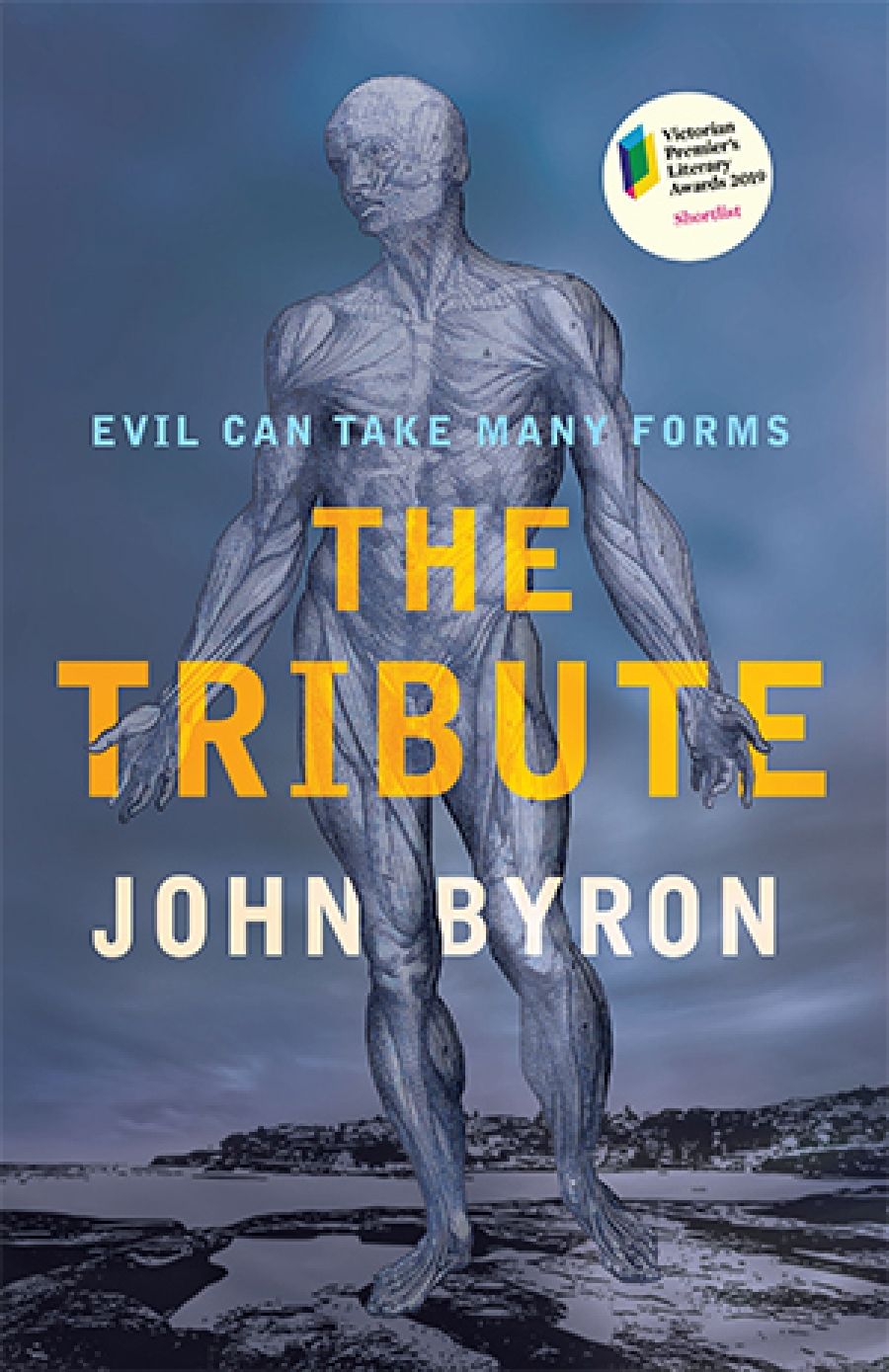
- Free Article: No
- Contents Category: Fiction
- Review Article: Yes
- Article Title: Monsters
- Article Subtitle: A Hitchcockian crime début
- Online Only: No
- Custom Highlight Text:
The Tribute begins with a corpse. And not just any corpse. This body is discovered in a Sydney terrace house with its organs removed. One detective describes the crime as ‘butchery’, and that’s an understatement. This murder is the work of Stephen Porter, a deceptively bland chap who uses his bank job to secure the schedules and addresses of victims. These victims are then dissected as ‘tributes’ to the Fabrica, a collection of sixteenth-century anatomy books.
- Featured Image (400px * 250px):

- Alt Tag (Featured Image): Jay Daniel Thompson reviews 'The Tribute' by John Byron
- Book 1 Title: The Tribute
- Book 1 Biblio: Affirm Press, $32.99 pb, 415 pp
- Book 1 Readings Link: booktopia.kh4ffx.net/0Jmq1O
The Tribute crackles with a tension that is relieved by some well-timed dashes of black humour. The first of these appears in the author’s bio, when we learn that John Byron ‘went to medical school for a time before leaving in the interest of the public safety’. This anecdote takes on a new resonance in the final pages.
The novel is written with a cinematic clarity; this reviewer could picture the events unfolding on a screen. Sydney, brought to life, plays a pivotal role in the novel, which shifts from the plush mansions of Double Bay to grungy outer-suburban offices, as the killer hunts his prey.
Fittingly, given the vivid prose, there are references to the Master of Suspense himself, Alfred Hitchcock. The director’s beloved term ‘McGuffin’ is deployed, and there’s a nod to Dial M for Murder (1954). The book’s conflation of food and death is reminiscent of Hitchcock’s Frenzy (1972). Thankfully, the reader is spared a shower scene.
There are some truly nauseating moments, which are to be expected given the nature of the crimes being represented. Fortunately, these crimes are not depicted voyeuristically, nor are they glamourised. They are as bizarre as they are despicable; unbelievable and unbelievably repulsive.
Throughout the book, Byron shows a flair for character development. This is nowhere more evident than in the depictions of Murphy and Porter as different sides of the same, sordid coin. Murphy’s ‘cruel, seething anger’ and violent thoughts amplify as Porter’s spree continues; indeed, by the closing pages, the only thing separating the two men is that Porter is willing to put into practice what his policeman hunter can only contemplate.
Further, the Murphy–Porter stand-off provides a perceptive commentary on masculinity and misogyny. Murphy is a case study; he’s paranoid that Sylvia has been unfaithful, and describes the domestic violence service she consults as ‘typical anti-male feminist victim bullshit’. There are no such outbursts from Porter, who rarely discriminates between men and women when it comes to killing, and whose crimes are driven less by hatred of women than by a twisted reverence for the anatomy texts.
Indeed, Porter embodies a masculinity that is just as dangerous as Murphy’s, but that is more childish in nature. The killer describes one victim as a ‘fiend’ and ‘monster’, and Fabrica’s author as ‘the Master’. There is the sense of a boy trapped in a man’s body, navigating a world that resembles a pop culture-constructed reverie. The reference to one of the victims as a ‘monster’ is particularly ironic, given the killer’s own deeds.
Refreshingly, The Tribute avoids psychologising about Porter’s motives. Reflecting on media reportage of his crimes, the killer abhors the ‘facile, sly, bigoted association between homosexuality and sadism’ (he appears to be heterosexual). Very little is known about his background, aside from a uniquely interdisciplinary education that assists him in his pursuits.
Also, the novel implicitly rejects a causal relationship between Porter’s crimes and his relationship with his mother. That rejection is itself a sly reference to Hitchcock’s notoriously mother-blaming Psycho (1960). Porter is as ‘odd but oddly forgettable’ as Norman Bates, but with none of the secrets that lay in Bates’s fruit cellar.
The chief female characters are well rounded and assertive; they stand their ground in an environment infused with blokey, retrograde sexual politics. The relationship between Joanna and Sylvia is sensitively rendered and moving. The women are united by the confidence they have in each other, as well as by their awareness of Murphy’s dark side. This joint awareness deepens as the book progresses.
That said, the Joanna–Sylvia relationship could have been developed. Similarly, Joanna’s dalliance with a female detective could have been elaborated on; it feels tacked on. Some details are not entirely believable. For instance, Porter’s office seems quieter and more isolated than the buzzing call centre that a person in his line of work might be expected to occupy. A scene where Murphy wakes from slumber, rightly sensing the killer’s location, seemed like the kind of swift, unimaginative way to move a plot on that one might expect from a Hollywood thriller. This moment is brief, but detracts from the text’s originality.
The Tribute was shortlisted for the Victoria Premier’s Literary Award for an Unpublished Manuscript in 2019. That is unsurprising. The novel heralds the emergence of a promising literary talent, and could easily be transformed into a film, one that critics might well describe as ‘Hitchcockian’.


Comments powered by CComment